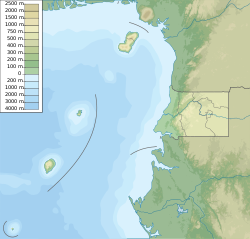This article needs additional citations for verification. (May 2023) |
Malabo
Santa Isabel (before 1973) | |
|---|---|
|
Top: Malabo skyline; Middle: Cathedral of Santa Isabel, Presidential Palace; Bottom: Spain Cultural Center, Bata Waterfront | |
| Coordinates: 3°44′44″N 8°46′28″E / 3.74556°N 8.77444°E | |
| Country | |
| Province | Bioko Norte |
| Region | Insular Region |
| Founded | 1827 |
| Current name | Since 1973 |
| Area | |
• Total | 21 km2 (8 sq mi) |
| Elevation | 0 m (0 ft) |
| Population (2018)[1] | |
• Total | 297,000 |
| • Density | 14,000/km2 (37,000/sq mi) |
| Demonym | Malabeño-a |
| Time zone | UTC+01:00 (West Africa Time) |
| • Summer (DST) | (Not Observed) |
| Climate | Am |
| HDI (2019) | 0.710[2] high |
Malabo (/məˈlɑːboʊ/ mə-LAH-boh, Spanish: [maˈlaβo] ; formerly Santa Isabel [ˈsantajsaˈβel] ) is the capital of Equatorial Guinea and the province of Bioko Norte. It is located on the north coast of the island of Bioko (Bube: Etulá, and as Fernando Pó by the Europeans). In 2018, the city had a population of approximately 297,000 inhabitants.
Spanish is the official language of the city and of the country as well, but Pichinglis is used as a language of wider communication across Bioko island, including Malabo.[3]
Malabo is the oldest city in Equatorial Guinea. Ciudad de la Paz is a planned community under construction in mainland Equatorial Guinea which was designed to replace Malabo as the capital. The institutions of governance of Equatorial Guinea began the process of locating to Ciudad de la Paz in February 2017.[4]
- ^ "Equatorial Guinea – The World Factbook". cia.gov. 7 June 2018. Retrieved 24 June 2018.
- ^ "Sub-national HDI – Area Database – Global Data Lab". hdi.globaldatalab.org. Retrieved 13 September 2018.
- ^ "Equatorial Guinea". Ethnologue. Retrieved 10 December 2020.
- ^ "E Guinea government moves into forest HQ". BBC News. 8 February 2017.







